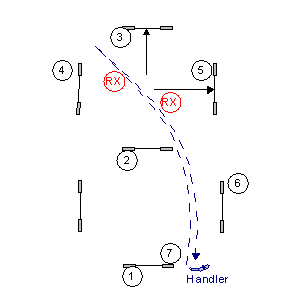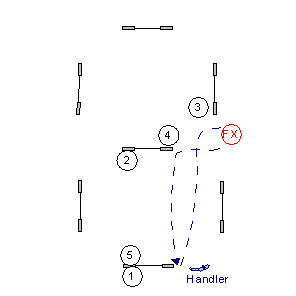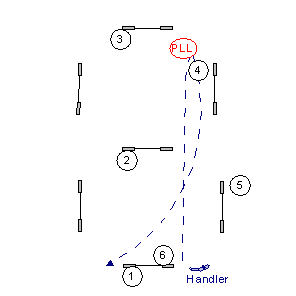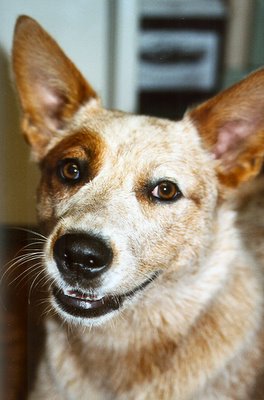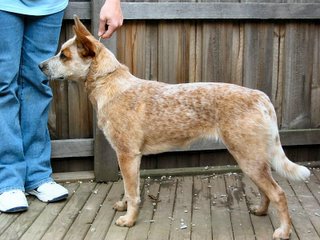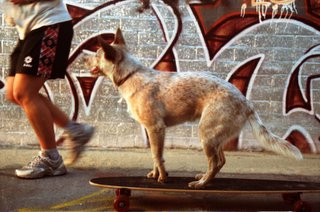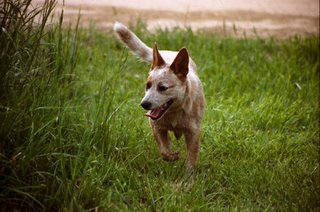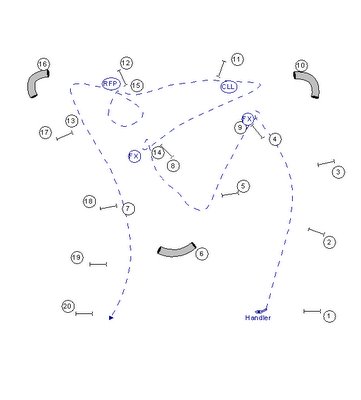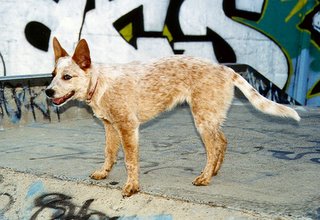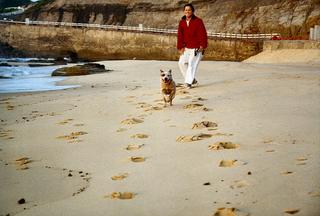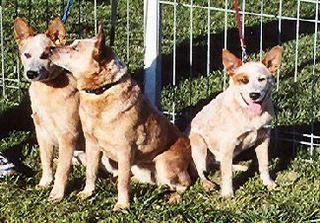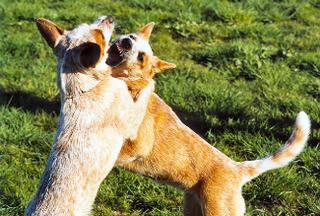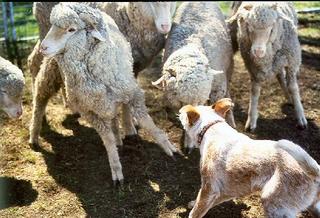December 31, 2005
No Cookie No Doie
Thinking about what becomes part of the cue, I went back to Sue Ailsby's training plan to fade treats and clicker from the equation. Sue says:
"Go to your most common training location with your clicker and maybe 15 treats. Put 10 treats on a table 5' away from you. Put 10 treats on a table 10' away from you, and put the rest on a table in the next room. Keep your clicker. Work on Sit from scratch until she's offering it to you eagerly and you've used up your initial handful of treats. Without any break, ask her for a Sit. Click, and go fast and happily to the closest table, get a treat and hand it to her. Make a pretty big deal of this. Go back to your training place, ask for another Sit, click and go back to the table to get a treat. Finish up the treats this way.
Now, seamlessly, go back to the training place and ask for another Sit. Click, and go to the 10' table. Continue until you've used those ten treats up, then work with the ones in the next room. Lots of work for you, running back and forth, but worth it to get the dog to trust that there will be a treat, even if she can't see one.
When you've run through that routine several days in a row, do the same thing again, but don't take your clicker into the game. Where you would have clicked, now you're going to use a word instead. I use YES! "
So that was today's game. I know there are trainers who say that the click must always immediately be paired with the re-inforcement or it will lose its 'charge'. But the click means what you teach the dog it means. And as Sue explains it, as the treat becomes more removed from the behaviour/click you replace the click with a word.
December 28, 2005
Swim training
Dusty played at the waters edge, but showed no desire to go in herself. So once the weather warmed up, I started going in myself and just standing about or doing a few strokes parallel to the beach. Duz would swim out to me with a look of grim determination.
Last week I started throwing Thommo's ball or stick out into the water for him to fetch and then running in after him calling Dusty. She followed us quite happily. This morning I didn't go in beyond my knees, but when I threw the ball for Thommo I called Duz. After a few goes, she was swimming out after him without any encouragement.
I think swimming is great exercise for them, and we can swim every day without effort, so I'm thrilled that she has decided she likes it.
December 23, 2005
December 21, 2005
Box Drills
However sometimes I do want to practice a particular handler movement, and for this I have some set sequences using the double box. These come from my notes from a Greg Derrett seminar, so there is a risk that I have misquoted or misinterpreted. The usual consumer cautions apply :-)
Front Cross
Rear Cross
Push Through
Pull Through
December 20, 2005
Contact
December 18, 2005
Puppy agility

Originally uploaded by Turtblu.
Found a photo of the cute red pup doing agility. Her name is Laika and this is a shot of her starting a run at the final class day of Puppy-agility, 4 months old.
Not sure about the guiding hand though. I'd be just standing there and letting her choose to go in the tunnel and rewarding her when she did.
Flickr red puppy
December 16, 2005
On your spot
Today my criteria is going to whatever target I indicate (mouse pad, bathmat, folded dog rug, crate pad) and waiting in a down for 5 - 10 seconds and I'm rewarding with a thrown toy to keep her focused out in front and to build drive from the target.
I realised that I don't often follow a click with a toy rather than food, so I'll try doing some more of that - pairing the click with a wider range of reinforcers. I have tried to get her playing a lot of different games with all sorts of things. Thommo I allowed to become obsessive over a tennis ball - he doesn't even like other sorts of balls.
December 13, 2005
Contact Behaviour
But is this what we really want? Don't we want the shoulders flexed ready to absorb impact? If a dog has his nose to the ground do we achieve that? Or is his weight now forward? If the dog were in the same position, shoulders low but head UP would more weight be forward or back?
Thommo tends to bring his head up to slow down, transferring his weight to his hindquarters; and to drop his head to accelerate, shifting his weight to his forequarters to drive off. This is the reverse of what a nose touch asks for on the contacts.
Almost every fibre in my body tells me that if Susan uses a particular method then it must be the best method - but there is one fibre that wonders whether a nose touch can really be best, particularly when Susan describes Buzz getting nose bleeds from the intensity with which he touches.
Another contact behaviour that seems preferable is the chin press. In order to press his chin to the ground the dog has to ease back, not bend forward. Also the chin press is a stationary behaviour, more easily marked and rewarded. And it doesn't involve the dog trying to breathe with his nostrils smushed into the dirt. An example of a chin press rom Greg Fontaine's dog Maverick - http://www.geocities.com/chinpress/chinpress004.wmv
There is also the down at the end of the ramp, the running contact, and the one rear toe on. We'll continue working the necessary pre-obstacle skills and make a decision later before we get to the equipment.
Targeting
However, I am beginning to think that for many people the problem that their dogs have with contacts in a trial - as opposed to training - comes back to the cue for the behaviour. In a trial situation it may be that the problem is that the dog is waiting for what it thinks the cue is for the behaviour. And this might be quite different from what we think we have trained.
This was demonstrated rather well by Greg Derrett when he asked us all what our start line release cue was and for many (most?) dogs it was something quite different. So while we thought 'Go!' was the release, Rover thought that it was the word go said after mum stops looking at me, drops her arm and takes a running step.
It could be that correct performance on the contact is cued by a similar chain. Rover has learned his lesson well, "I stop with 2 feet on and 2 feet off when I can see that clear square thing , and mum sort of leans over the end of the board and points, and she has her other hand in the treat bag, and she says 'touch' in that smiley way she has when she is happy with me." If any of these elements are missing then it is not the cue for 2o2o.
The behaviour was not on stimulus control before it was transferred to the contact obstacle. We’re so pleased the dog is nose-touching the target, stopping 2o2o, dropping on a target, we move on to doing on the equipment long before the dog recognises the cue for the behaviour. What we need to establish is that Rover knows (and we know) the specific cue for the behaviour sufficiently well to perform it in a variety of circumstances.
With Dusty I'm working on a number of pre-contact obstacle skills. I haven't yet decided what her contact behaviour will be, I'll watch her and see if there is a natural behaviour that I can put on cue. With Thommo, the worrywart, I had to be careful not to do anything that he would interpret as a reproach so we didn't use a stop. I clicker trained him to run to the very end of any board, plank, steps, ramp, children's slide, skate pipe ... without jumping off. He has only ever missed a contact in one event.
I've been working this with Dusty too. We started with just a board flat on the floor, rewarding for going all the way to the end, and on a low wall in the park. Yesterday in the skate park she was doing great runs up quite a steep quarter pipe, and then running back down. I'd click as she got to the level area and drop a treat at her feet. After a few repeats she was running fast back to the end of the slope and stopping for her treat.
This morning I set up a hinged board across my ottoman, and encouraged Duz to jump up onto the ottoman. I then rewarded her for running down the sloping board to the end. At first I just clicked as she got to the end of the board, later I clicked when she paused at the end.
I hadn't done any work with a foot target with Dusty. But after working with her and the board I put a mouse pad on the floor for Thommo to earn some treats. On 'spot' he ran to the pad put one foot on and came back for his treat. Duz was just waiting, watching the treats (learning that even if treats are around she doesn't necessarily get one). Thommo touches the pad three times, three treats. Dusty then runs across, does a perfect one paw touch and comes back for her treat.
Entertained, I then called a name before saying 'spot' and tossed the treat in opposite directions for each dog, to give the other time to get to the target. When I thought the name had become part of the cue I made it harder, getting them to wait for their turn. A touch without a cue didn't get a reward. Dusty picked it up as quickly as Thommo.
Not sure how useful this will be, but it was fun.
December 11, 2005
Death of a Pet
I was grateful for the support of the agility community at the time. My social friends' and relatives' response was "Oh pity, but you'll get another dog?" It was only my dog-lover friends who could offer real sympathy and advice.
Greg Derrett lost Jaycee to cancer in October. I felt I knew her from Greg's videos and from how her talked of her in his seminars.
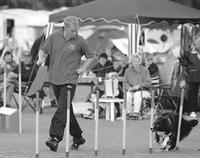 Greg supervises Jaycee Sproglett through the weaves.
Greg supervises Jaycee Sproglett through the weaves.
December 08, 2005
Advent Calendar
While you are there check out the party games and the glossary of agility terms.
The Zen of Dog
Letter 1
My dear puppy,
I have nothing to teach you, save a few basics
like sit, stay and heel, all meant to protect you
from the occasional folly of a careless man.
You, on the other hand, by nature are the very embodiment
of essential happiness and unconditional love.
Let me open my heart and embrace your instincts.
Teach me dog.
Tricks of the Trade
- leather kennel leads,
- grooming table with a low crossbeam,
- sturdy, hinged grooming arm.
Chapter two looks at puppy evaluations, saying that a breeder's goal should be to breed for:
The evaluation process consists of:
- For structure, evaluate puppies only at eight weeks, give or take three days either way.
- Evaluate the whole litter.
- Keep a written record of each evaluation.
- Select an objective grading system.
- Evaluate puppies at a place completely unfamiliar to them.
- Have someone unfamiliar to the puppies handle them for the evaluation.
- Evaluate puppies in a mirror.
- Let your fingertips be your best set of eyes.
- Be consistent in your evaluation steps: check temperament, look at the puppy in a suspended position, look at the whole puppy in a standing position, look for overall balance, check proportions, evaluate nutritional effects on structure.
Pat emphasises the value of good nutrition, but says that 'good' nutrition does not mean high powered puppy formula with supplements. Over feeding is as dangerous as underfeeding, she says in the chapter on nutrition, and that the food that keeps your adult dogs in good condition is safe to feed to your puppies from day one.
The last chapters of the book deal with 'teaching' rather than 'training' - puppies grow up more confident if the are taught to think for themselves rather than follow routines - with general management tips in caring for a show dog - professional handlers win because they take better care of the dogs than owners do - with displaying the dog's structure in the show ring - the appearance of a show dog is created by head and neck carriage - with grooming - the best groomed dogs at a show should be the agility dogs, becuse they are the ones that the public watches - and with presenting the dog's attributes in advertising for sale.
December 07, 2005
Pat Hastings
Another Piece of the Puzzle is a collection of articles, by authors including Pat, Brenda Aloff and Karen Pryor, on puppy development from the pre-natal period to maturity. The book has lots of practical information and advice including invaluable Tips and Tricks for breeders and owners. In the puppy training issue of Clean Run (V10, N5) Pat talks about structure in the agility puppy.
The Puppy Puzzle video and evaluation forms provide a framework for assessing the structure, presentation and temperament of puppies at around eight weeks old.
Tricks of the Trade discusses all of the elements that go to make up a winning performance in the show ring, which is the sum of effective breeding, evaluating, rearing, teaching, conditioning, nutrition, grooming, care and presentation. Again, what I love about this book are the dot point tips such as "To give your dog an advantage in the ring, always lead it through a stretching exercise before showing" and "When bathing a dog that has stains use only lukewarm water. Hot or cold water will set the stains."
November 30, 2005
Handler Movements
Handling Techniques in Agility by Solveig Trippestad, an encyclopedic resource describing in great detail a wide array of handling movements.
Agility Moves and Situations is Guy Blanke’s video clips of terms that describe situations handlers find in agility training and competition.
Handling Techniques from a list of FAQs compiled from Agility email lists.
Crazymaesy Agility Handling Notes by Jo Fraser and Iain Fraser, two leading British trainers and competitors.
Perfect Timing abridged from a Bud Houston article in Clean Run
November 28, 2005
November 23, 2005
Challenge Certificate
Challenge & Best of Breed - Ikenheel Diamonds N Dust
Handling Sequences
- The speed of the dog and the handler.
- The efficiency or competitive edge that each option provides.
- The recoverability factor - if the option chosen should go pear-shaped, how easy is it to get back on track.
Course Sequences
- Changes of direction greater than 30 degrees.
- Obstacle discrimination challenges.
- Sharp turns towards handler.
- Places where the handler needs to change sides.
Running the course as a series of sequences enables the handler to leave negotiating individual obstacles to the dog, and to get into position to help the dog with the 'breaks' in the flow.
November 19, 2005
Virtual Agility
Course Analysis
This second book in a series by Stuart Mah looks at agility courses from the handler's perspective, helping the handler to make the correct handling choices for their dogs. It explains agility terms, course elements and patterns, and describes the handling maneuvers that agility handlers need to understand to analyze a course and their handling options. The book gives handlers a specific plan they can follow to analyze courses and includes chapters that present obstacle sequences and courses so that handlers can practice their analysis skills.
Quibble number one: there is not a lot of information in the book. Between the large amount of white space and the repetition of information I was left feeling that it could have been a much smaller (and cheaper) book.
Quibble number two: Stuart regularly uses and advocates the use of the blind cross. I've adopted Greg Derrett's philosophy that my dog should never think it is ok to zip around behind me but will always be in front of the plane of my shoulders.
Even with these reservations, however, it is a well structured lesson in how to objectively plan handling techniques rather than make those decisions on the fly.
November 18, 2005
Skate Park
November 15, 2005
Nested Jumpers Courses

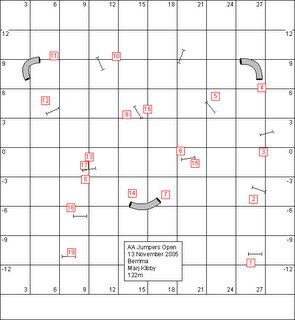

Having completed my judges' training for Agility Australia, I had my test assignment on the weekend. It was the day after the Titles and everyone was in a relaxed mood and out to enjoy the perfect weather and pleasant grounds at Berrima - which worked to my advantage.
The courses seemed to run well, particularly the Novice course which had room to play it safely, or to practice some more advanced handling techniques.
Agility Australia courses are planned to test participants at the appropriate level of competition, and to engender enjoyment and safety with the flowing layout of the obstacles and well-designed challenges.
November 06, 2005
Pet astrology
- "ARIES need to be first! If you are looking for a pet that will become a champion, choose an Aries."
- "CAPRICORN These hard working little guys are very stubborn. They want something and they don't give up."
Don't know your dog's birthdate?
- Dusty - 17/04/2005
- Thommo 07/01/1999
- Dusty & I
You both will certainly create a lot of fireworks. Leo and Aries are fire signs. They have healthy egos and when they clash, all innocent bystanders should take cover. This relationship can last! - Thommo & I
Capricorns are too much of a dreamer to enjoy the present. Eventually Leo will find this relationship exasperating, but don't give up. There is much to share.
Thommo's Horoscope

Capricorn: Overindulging in the wrong foods puts your tummy in a tumble, even too much of a good food can cause problems. Remember the old saying, ’sometimes your eyes are bigger than your stomach’! Once you’ve experienced such physical distress you learn to be more careful with your eating habits. Digestion is a natural process and you can help it along by not going to any extremes after eating. That means don’t lie down right away and don’t go for too vigorous a run either!
Dusty's Horoscope

Aries: It’s fun to see new things and explore new places and you’ll be tickled to get the chance to do just that when your human friends take you along on a whirlwind trip. But there is a downside to this otherwise interesting week; it’s about deciding who’s in charge! As much as your companions think they rule the roost, you hold to the idea that the world revolves around you. Be careful that you don’t land in the doghouse over your quest for power!
Indoor Games
Hide and seek.
Have your dog stay, or get someone to hold him, or distract him with a thrown treat, the slip around the corner or crouch behind the sofa.
Which hand?
Hold a small treat or ball in one closed fist and keep the other fist empty. Extend both arms out and ask your dog, "Which hand?" Let it sniff both. When it noses the fist with the toy or food, open your hand, show it, and praise. Repeat, randomly moving the toy or food into your left or right hand.
Find the keys.
Toss the keys to get her attention, then reward any move towards them. Work up to her bringing the keys to you. Stash the keys in plain view, then work up to hiding them behind a cushion. I've found this useful on three occasions over the years when I've been able to send Thommo through the dog door to get the keys when I've locked myself out.
Bring me ...
Dogs like having a job. Teach him to bring the remote, and the tv guide, and a beer and a packet of chips, to the sofa where you are lying.
El Matador
Wave a towel or blanket provocatively while shouting "Toro, Toro!" in your best Spanish accent. As your little bull charges whip the towel away at the last minute.
Luke, I am your father
Talk to your dog through the cardboard cylinder of a paper-towel roll.
Patty Cake
When your dog is lying down put your hand on top of one paw, he'll probably pull it away. Put your hand on top of the other paw and so on.
Activities from 97 Ways To Make Your Dog Smile by Jenny Langbehn - worth buying for Pat Doyle's wonderful dog portraits alone.

November 05, 2005
Squeaky Deaky ...
Songs to Make Dogs Happy! is the first research backed musical CD for dogs, based upon 200 canine participants’ decisions as to what they would like to hear in songs.It was created by the Laurel Canyon Animal Company, which has utilized the services of psychic animal communicator Dr. Kim Ogden-Avrutik, and spent over a year developing and testing the songs. Canine focus groups selected from dogs nationwide were assembled and questioned as to their preferences in music and content.
What dogs didn’t want:
Some kinds of percussion
The word “no”
What dogs did want:
93% wanted to hear that their “human companion loves me”
93% want to hear a song about having a dog bed
92% want to “tell my human I love them”
87% wanted to hear a song about a toy
87% wanted to hear a song about eating food
75% wanted to hear a song about being outside
Topics were chosen based on these findings, songs written, reviewed by Dr Kim, recorded, tested with more canine focus groups and adjusted in the light of the comments.
“Songs to Make Dogs Happy helps ease separation anxiety. It is very effective when played in the car while traveling with your dog. It reinforces the bond between humans and their dogs and helps relax both in stressful situations when used according to the instructions provided” says Skip Haynes, the creator of the album. Listen to sample tracks.
Hey!! If it makes the dogs happy ….
November 02, 2005
Dusty Meets the Sheep
 This was Dusty's first encounter with sheep - I've only just got around to uploading the video. I was a little concerned that she'd leave the yard, or stop to eat sheep poo, during the test last weekend. But she 'stayed on task'.
This was Dusty's first encounter with sheep - I've only just got around to uploading the video. I was a little concerned that she'd leave the yard, or stop to eat sheep poo, during the test last weekend. But she 'stayed on task'.I've sent my entry away for another Robert and Jenny Cox seminar at Uralla in January. I loved the way that Jenny brought Dusty along, with encouragement and praise.
November 01, 2005
Reliable Recall
Condition a reliable recall by building a reinforcement history:
- When calling crouch slightly and turn away from the dog, and use three short syllables to call – ‘pup, pup, pup’.
- If your dog is coming to you of his own accord, call him.
- Carry treats and reward checking in with you when off leash.
- Call, reward and release to continue playing – the recall does not stop the fun.
- With your dog on leash, call him away from distractions such as a thrown treat, and heavily reward coming.
- If you think your dog might not come to you don’t call him, just go get him.
- Don’t call him for anything he might not like to do.
- Don’t use his name to chastise him.
Canine Trivia
On the Saturday night we had a canine trivia quiz over dinner, which got everyone talking. One table ran out to the car for a book, another phoned a friend. Robert Cox wandered around the tables with friendly queries about how people found the trial, which everyone thought was a lovely touch until we realised that he was none-too-subtly reading our answers.
How many teeth does a dog have?
Dogs are born with no teeth at all, but grow them in the first two or three weeks after birth. At around eight weeks of age, a puppy should have a full set of twenty-eight teeth (some breeds may have a slight variation), consisting of pre-molars (not full molars), incisors, and canines.
An adult set has forty-two teeth: twenty-two on the lower jaw (mandible) and twenty on the upper jaw (maxilla): twelve incisors, four canines, sixteen pre-molars, and four molars on the upper jaw, and six more on the lower jaw.
What is the name of the dog in Frasier, and the actor that plays him?
Moose, a Jack Russell Terrier, portrays Eddie.
What is another name for the Russian Wolfhound?
The Russian Wolfhound is also known as the Borzoi or the Psowaya Barsaya.
Name six retrievers.
- Labrador retriever
- Golden retriever
- Flat-coated retriever
- Curly-coated retriever
- Chesapeake Bay retriever
- Nova Scotia Duck-Tolling retriever
October 31, 2005
Another 'sister'
 At Uralla we met up with Toni Simmonds and Ochre - a half sister to Dusty, both by Gr Ch Bangeeri Aussie Alchemist. While Dusty has black eyliner neatly applied, Ochre has wonderful black smudges around both eyes. She is on her way to her Herding Started title, but has taken a break recently to become a mum. Dippa and Ember have just gone to their new homes.
At Uralla we met up with Toni Simmonds and Ochre - a half sister to Dusty, both by Gr Ch Bangeeri Aussie Alchemist. While Dusty has black eyliner neatly applied, Ochre has wonderful black smudges around both eyes. She is on her way to her Herding Started title, but has taken a break recently to become a mum. Dippa and Ember have just gone to their new homes.
Clarence Herding Trial
The test/trial process is a complicated one, but the requirements for each event are straightforward, and our judges, Jenny and Robert Cox, were generous with their explanations. There is nothing on the RNSWCC site about herding regulations, and if they are on the ANKC site there they aren't immediately obvious. To find the regulations you need to go to the CAWA web site.
I had been building a strong reinforcement history with Dusty for a downstay and recall so I was fairly confident of this part of the test, though in the yard with the sheep at the beginning of the instinct test was a new experience. I have also tried to keep to the really reliable recall guidelines, and her recall off the sheep has been good in the past. But she is still a puppy - she was just old enough to enter by a week, and she has only seen sheep twice in her life, the last time over a month ago.
"For both the first and second leg tests, the passing dog should show good, sustained interest of such a nature that the dog appears to be ready to begin preliminary training. Strong desire and a well adjusted, willing attitude should be demonstrated. The overall impression should be that the dog has the potential to be a useful, practical working dog. Constructive herding activity, not chasing should be evidenced."
Dusty did seem to be herding, keeping to the outside of the group and trying to keep them together, not rushing at them or trying to get them. It was hard, though. The sheep that we train with were attacked by dogs during the week, so were replaced by fresh sheep - nowhere near as accustomed to being herded by dogs.
But she did it. She gained a qualification in each of the two tests, so now has a Herding Instinct Certificate, and is ready to begin training in earnest.
October 27, 2005
Skateboarding Step by Step
Skateboard in the middle of the room, pillow restricting movement.
- Dusty backs up (recently learned, not on cue)
- one foot on board CT
- two front feet on board CT and call her to me for a pat
- she backs up
- two front feet on board CT
- three feet on CT
- wait for fourth foot, she lies down and puts her chin on the board, very cute. call her to me.
- hops up with four feet CT
- stays on board with four feet CT
- stays on board with four feet CT
- call her to me with lots of praise and a tummy scritch
- runs back and hops up with four feet CT
- stays CT
- stays CT
- release and play smack a puppy.
Session two
Skateboard in the middle of the room, pillow restricting movement, count out three lots of ten treats, raised the criteria to four feet on the board.
- Dusty runs over and hops up on the board CT throwing treat off to the side so she has to get off the board
- Repeat until she has had the ten treats, release and play.
- Repeat, for another ten treats.
- Repeat, this time rewarding facing the front of the board.
Session three
Took away the pillow so the board could move, on carpet so it doesn’t move too fast, criteria moving the board while standing on it with one or more feet. Ten treats.
Session four
Still on the carpet. Two rewardable behaviours: either standing on the board with all four feet, or pushing the board along while having one or more feet on it. I have never tried having alternative criteria so not sure if it will work.
Session five
Rubber bands against the wheel bearings slow the board down, we move outside to our street which slopes down to the gutter. Rewarding either hopping on the board or pushing it along.
Session six
Taken the rubber bands off the board, reinforcing jumping on the board and staying on it for five or ten seconds as it rolls. Dusty tends to stand on the nose rather than in the middle, so I probably missed a step reinforcing her for the correct position on the board.
Session seven
Breakthrough. Dusty combines the behaviours, pushing with one foot while staying on the board.
Session eight
Captured on film.
October 26, 2005
Dusty Skating
Air Dogs
Good to see more of those things I've been drooling over on overseas web sites - or braving exchange rates and postages costs for - now available from an Australian source. Air Dogs has a easy to navigate site, a good and expanding range of products, and a range of ways to purchase.
Running and Jumping
When we do restrained recalls I encourage the excitement and direct it onto a tug toy. But I haven't ever trained her to be calm while I'm running. So this week we have been doing free running, off leash, for short distances (not that my running long distances was an option), either in a straight line or in a circle.
This reminded me of Greg Derrett's basic agility skills training, so I watched the video again. Agility Foundation Training stresses the importance of 'circle work' - getting your dog accustomed to running with you, on your left and right, on both the inside and outside of the circle. The dog not only gets used to the thrill of you running, but also learns to read your body language and position himself in relation to you.
Greg's Agility Foundation includes:
- Get the dog you want.
- Give it a short sharp name.
- Study basic learning theory.
- Teach it to play, including tug.
- Become more rewarding to the dog than the environment or the equipment.
- Develop a solid wait with strict criteria.
- Have consistent release commands.
- Teach directional commands - left, right, go on.
- Practice circle work.
- Have a regular fitness routine.
October 23, 2005
Sewing for Dogs
Like most things these days, there is plenty of information online on how to get started:
October 22, 2005
Swimming Lessons
Today was a balmy 26C, so I took them both down to Horseshoe beach, the local off leash area. It is on the harbour, so unless a ship goes past there aren't any waves to contend with.
I went out to about waist deep, and she swam after me. She had this look of grim determination and when she reached me she immediately swam back to shore, but she kept coming back out again. So I think she'll take to it. She had really good flotation, and excellent paddling action. I'll take a floating toy or two next time and play with her out in the water.
Seminars on CD
Sessions, such as Nelson's, are available individually for US$14.00 or you can purchase the whole conference. They don't provide any details on the session, just the title and speaker so you have to either do some research or take a chance. Jean Owen - Advanced Agility Handling Skills with One Jump - sounded worth buying on spec, but a few moments Googling revealed Owen's expertise.
Might be something to listen to on those long drives to trials.
Canine SIM Games
Simulation games have been played with pencil and paper since time immemorial. Recently, simulation games have come to the computer. Computers are inarguably superior to humans in creating simulations, and they have allowed simulation games to become more realistic than ever before.
PawIt, Canis Major, Showdog.com, and Furry Paws, all allow you variations on raising, training, handling and competing with a virtual dog.
October 21, 2005
Don’t Shoot the Dog
A decade later, when I had my first dog that I wanted to train to a competitive level, rather than to just walk beside me and to hop off the sofa when asked, Don’t Shoot the Dog was again recommended to me.
The principle behind Karen Pryor’s reinforcement training is based on behavioural science and nearly a century of controlled experimentation, but the principle in itself is very simple:
- A reinforcer is anything that, occurring in conjunction with an act, tends to increase the probability that the act will occur again.
A punishment is an aversive stimulus that occurs after the behaviour. Punishment does not result in predictable changes to the behaviour.
So a police car on the freeway is a negative reinforcer that increases the chance of your driving within the speed limit. A fine two weeks later in the mail from a hidden speed camera is a punishment that will have no predictable effect on your driving speed. A safe driver program where your eTag was automatically credited with $10 for every kilometre safely travelled uses a reinforcer and would tend to increase the possibility that you would drive within the limit.
October 19, 2005
A Short History of Dog Training
Most's training approach was widely adopted as the model for military training throughout the world, and is still used today for many military, police and service dog training programs. Although his techniques, which rely a combination of “inducements and compulsion,” use collar corrections and punishments that are considered heavy-handed from today's perspective, Most's methods are based on the principles of operant learning that form the basis of clicker training. Most was one of the first to see dogs, not as moral beings capable of spite and eagerness to please, but as dogs with their own system of reasoning.
Most's training techniques spread throughout the world as his students and disciples emigrated to other countries. Josef Weber (The Dog in Training, 1939) and Hans Tosutti (Companion Dog Training, 1948) opened schools for training dogs in Philadelphia and Boston respectively. Tosutti, writes “Another piece of equipment against which I warn is the plain choke collar. In order to obtain results with a collar of this type, the guide must pull on the choke to the point of strangling the dog until he loses his breath. I have seen dogs with necks strained and seriously injured from being trained with choke collars simply because of the strength that can be exerted when the guide brings the dog up short with a quick, hard jerk.” He felt that felt that the choke collar, “though quite innocuous in appearance, is an instrument of torture in the hands of the beginner because of its unlimited choke.” He may be suprised to see the widespread acceptance of the choke collar as a beginner's training aid today.
Marion Bailey and her first husband, Keller Breland, were graduate students of B.F. Skinner. Leaving graduate school in the early 1940's, they started Animal Behavior Enterprises - a business that trained and provided scores of animal species for commercial purposes. Keller Breland was the first dog trainer to use a clicker - a tin cricket - to bridge the time between the behavior and the delivery of the reinforcer. He used the sound to mark the desired behavior when training field dogs and herding dogs work in a field away from the handler. Breland called the click sound a "bridging stimulus."
It's possible that Breland's training approach using operant conditioning with a conditioned reinforcer might have spread beyond his own business, had not WWII solidified the military model in pet dog training.
William Koehler, who like Most was a military dog trainer, was located in Hollywood and gained exposure through celebrity clients. His book the Koehler Method of Dog Training was, and may still remain, the all-time best selling dog training book, forming the basis for virtually all dog training from the 1950's into the '70's. This method is closely based on Most’s combination of praise and corrections.
Meanwhile clicker training was being used by Keller Breland with other species. In the 1950's Marineland hired him to develop a training program for their marine mammals. In a matter of weeks, Keller devised the system of marine mammal training that is still in use today. The Brelands worked with many trainers and associates who worked in a variety of locations, including Sea Life Park, which was then owned by Karen Pryor and her husband.
Skip ahead a few years to 1984 when Karen Pryor wrote Don't Shoot the Dog, a guide to human interpersonal relations. Serendipitously, the book's title brought Pryor to the attention of dog trainers. Pryor met Gary Wilkes - a professional dog trainer and the first person since Keller Breland to use clicker training on a wide variety of dogs in a wide variety of applications. Gary and Karen combined to do seminars together and the die was cast for the word of clicker training to spread throughout the dog-training community.
Are You a Modern Trainer?
October 16, 2005
Shelters



I'm looking for a new shelter for trials. There seems to be three popular styles - the Coolaroo type with poles that you dismantle; the uTents that use a beach umbrella as a support; and the First-up styles that fold up concertina fashion. None seem perfect, so its a trade off between cost, weight, and ease of assembly.
October 13, 2005
Gaiting
My training partner suggested that I was encouraging the jumping by starting off with a little leap myself, and by rushing turns, so I first sorted out what I was doing with the help of a bunch of keys tied to the leash and a video camera.
Then we worked on 'off', calling Dusty to jump up and petting her, and then rewarding 'off' with a treat. After a couple of days of practicing this with myself and the neighbours, she was reluctant to jump up even when asked. Dusty is one to cut to the chase, and she learned fairly quickly that 'off' got liver and jumping up just got her hair mussed.
Finally - and this is perhaps where I should have started - we followed Sue Ailsby's guidelines to Conformation Gaiting and are working towards my arm out to the side being the cue to gait beside me, looking ahead.
October 09, 2005
FCI World Championships
Greg Derrett won the Individual Large Dog Agility, but blew the Jumping course as his dog entered the weave poles with the first pole on its right shoulder. Looking at the course and the run the mistake is understandable - in attempting to bring JT around his body for a straighter approach to the poles, he pushed her too far and around to the far side of the poles. He actually seems indecisive as to how to handle the approach, and may have even made contact with JT - she seems to stumble.
October 08, 2005
The Puppy Puzzle
The chapter Picking Your Agility Puppy could just as usefully be titled Picking Agility for your Puppy; Dusty came first, and I'll now decide whether agility is an activity we'll do together. In evaluating a puppy for agility, Elizabeth Barrett looks at structure first, then temperament.
Structure:
- Overall Balance: height, length, depth of body, and length of leg are in proportion, and puppy walks steadily and stops 'four square'.
- Front Assembly: good shoulder angulation; strong, straight parallel front legs; tight cat feet and barely sloping pasterns will assist in sharp turns and shock absorbtion.
- Rear Assembly: well proportioned with moderate angulation that will provide both propulsion and stability.
- Back: too long and it will be susceptible to stress, too short and it will lack flexion.
- noise tolerance
- confidence
- social attraction
- toy interest.
October 05, 2005
October 04, 2005
Open Agility (ANKC)

This is my drawing of the opening sequence of the Saturday morning Open Agility course. There seemed to be as many ways of handling it as there were dogs running. I started with Thommo on my left and handled 1-2-3 with the Serpentine movement that Greg Derret teaches. This gave a nice line to the weave pole entry. An outstretched arm would send him out to 7, and 7-8 required a nicely timed and positioned front cross.
ACT Trials
Thommo was in one of his moods where he won't do the weave poles. He sees the poles, stops running, brings his head up and walks down the opposite side of the line of poles from me. He did the poles perfectly for the first couple of years we competed, then developed problems in trial situations. I handled the problem badly, trying to follow everyone's (different) advice, and now he'll have days where he does them beautifully, and days where he refuses to attempt them.
So I decided that the weekend runs would be about my handling, not his running. We had some great courses on which to do this. I particularly liked Murray's Open Agility on the Saturday morning, one of three nested courses, with appropriately interesting challenges at each level.
September 25, 2005
Backing up.
Their soft-sided crates are in the living room so I used them to create a chute along the wall. I sat cross legged at one end and Dusty soon came up the chute to investigate. I held out a piece of chicken in my closed fist. She has already learned that the best way to get what is in my hand is to not touch it, so she had a sniff and pulled back. Click - and I threw the treat between her front legs so she had to back up to get it. (Click for behaviour, treat for position). She got the idea fairly quickly, as the chute left her with limited options. We had three short sessions and she was backing up to the end of the chute, about a dozen steps.
Today we tried it again without the crates. We started from scratch, rewarding any move backwards with a click and a treat thrown between her legs. She was soon up to three or four steps back as I gradually increased the criteria.
Then I was distracted and didn't click in time. She had taken several steps back and as I looked back to her, she droppd into a down. While I looked at her, wondering what I should do now, she had a 'lightbulb moment' and scooted back in the down position. Big hugs and lots of praise.
While I am training Dusty, Thommo practices waiting in his crate with the door open. I toss him a treat and a good dog when he is relaxed. I then put Dusty in her crate (door closed) and have a short game with him before another session with her.
Ruby's 17th Birthday
September 24, 2005
Sheep Game
September 19, 2005
Stock Dog Handler's Workshop
The workshop was given by Greg Prince, Australia's most successful stock dog trialler. He was great. I've been to agility workshops where the instructor talks about effective, positive training but never thinks to apply those principles to the human students. Greg's patience and sense of humour never failed him.
Greg has a ten step training plan:
- Instinct (Bring it out)
- Teach the first command, `the call' ( a dog must come to it's name)
- Balance (To me) with no commands.
- The Stop (The most important command)
- Teach the sides
- Teach to come off balance.
- Force (Bark and Bite)
- Keep Off (7 & 8 are taught simultaneously)
- The cast
- Backing and Barking (The extension of 7 & 8).
He taught each step, then those who were up to that stage tried it and the others practised the step they were at. It was a good way of letting us see what we were working towards, without over-reaching ourselves.
Dusty seems to have the instinct, and a good call even in the presence of sheep. However when we started to work on balance we were using a rake as an indicator to change direction and go back behind the sheep. Whenever I put the rake out in front of her she thought this was a new game and started to bite it. Still, some dogs were so afraid of the rake that they left the yard, or cringed by the fence.
We have started to work on using the clicker to train her to change direction when the rake is placed in her path.
Agility Australia
The courses are open and free flowing, and elite performance is primarily about being able to shave seconds off the time with precise handling, rather than being able to negotiate tricky traps.
They emphasise safety; there are no spread or broad jumps and no table obstacles. And they place a premium on sportsmanship; speaking harshly to your dog or to the judge will get you eliminated.
All of the events are significantly different. Agility Standard has a full range of equipment and requires distance handling, Jumping has only jumps and tunnels, Tunnellers has only tunnels, Weavers has tunnels and weaves, Touch and Go has contact obstacles and tunnels.
September 17, 2005
T-shirts
September 16, 2005
Working at a Distance

This week with Thommo, I am continuing to work distance exercises, particularly those that require layering obstacles. This one I started with him on my left and me wide of jump 1 so that I could run parallel to his path to the tunnel with my left arm extended. I handled 3-4-5 as a serpentine, which meant that he turned tight over 3, and I brought him home on my right. It took a couple of goes to get it smooth, keeping up forward momentum without travelling too far.
One of Sue Ailsby's level two skills is distance work, so I have also been doing that with Dusty. I shaped her to go around a tree stump at my feet then gradually increased the distance, and then practised on other posts and poles, working up to a distance of about two metres. Susan Garrett also has a similar "Get Out" game for puppies.
Helix Fairweather has a "Get It" game that also reinforces the dog for looking ahead, I'll look up my notes and start that over the weekend.
September 15, 2005
September 08, 2005
Distance Exercises
Mark a gamble line 1 to 2 metres away from a line of jumps, and place your dog between the jumps and line. Get as close as possible to the line, turn your feet outwards to facilitate this, and lean forward to get even closer. Now, send your dog over the jump; you may flail your arms wildly and scream as necessary. Continue until this approach seems pointless.
Exercise 2:
Set up a gamble line as before. Run as fast as you can towards the line then stop dead (think of a dog sitting on the roof of your car, as you stop, woosh, the dog will accelerate past you). Repeat until it becoms evident that just as your dog accelerates with you, it also stops when you do.
Exercise 3:
With the gamble line set up, run along it throwing an imaginary ball or otherwise flagellating your arms wildly in a windmill fashion. Continue until your dog is conned into believing you have thrown something, or you manage to affect weather patterns and create a wind that propels your dog over the gamble obstacles.
Exercise 4:
Learn the Laws of a Dog in Motion
- The dog turns when the handler turns.
- The dog tends to work on a path parallel to the handler's path.
- A dog ahead of the handler tends to turn back to the handler's position.
- The dog gets its speed cue from the handler's speed
- the dog gets its direction cue from the handler's body language.
Agility Training
I first did some work with Dusty. We set up a seesaw plank on the ground, with about an inch of tip possible. I free shaped Dusty to put two paws on, four paws, take a couple of steps, a few steps, and walk along the plank. This was the sort of game she loved. We then did some front cross practice on the flat and then with two jump uprights spaced about two feet apart.
I put her in her crate and brought Thommo out and we stood and watched while a couple of dogs ran the exercise that had been set up to practice distance handling. He sat calmly at my side and I occasionally rewarded that with a treat.
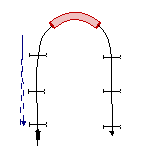 I ran with Thommo - one jump, tunnel, jump - then tried the three obstacle sequence again but this time staying on the left of the first row of jumps. I got myself in front of the jump, and Thommo came across when I stopped moving forward so we tried again, from the start. When he came out of the tunnel I was heading back down with my left arm outstretched. He did the far row of jumps without hesitation.
I ran with Thommo - one jump, tunnel, jump - then tried the three obstacle sequence again but this time staying on the left of the first row of jumps. I got myself in front of the jump, and Thommo came across when I stopped moving forward so we tried again, from the start. When he came out of the tunnel I was heading back down with my left arm outstretched. He did the far row of jumps without hesitation.An instructor suggested that I put Thommo away and work with Dusty again, playing tunnel games working on building speed and drive and enthusiasm. I don't think she was ready for that under those circumstances, she got quite hyped and lost all focus on me. So I took her off to the side and rewarded her for calm attention, gradually moving closer to the other dogs.
The other exercise that had been set up was to practice tight turns out of a tunnel. Thommo is fairly attuned to where I am so this exercise is easy for him if I get myself in the right position and cue him early.
September 07, 2005
Stockdog Trial Dates
24th September, 2005. Novice & Open, 8.00am start. Contact: Faye Gray, 02 6579 1961
THE AUSTRALIAN CATTLE DOG TRIAL CHAMPIONSHIPS
7, 8 & 9th October 2005 at Gundy via Scone The trial will consist of a Maiden, Novice & Open section. Contact Richard Stokes PH 02 49923430
AUSTRALIAN STOCKDOG CLUB SHORT COURSE TRIALS
Erskine Park. 18 -19 Nov.2005 An encourage and Open event on each day sponsored by Pedigree. Contact: Mrs Barbara Stitt, 25 Howard Road, Minto Heights, 2566. 02 9603 2880
CITY OF SYDNEY SHEEPDOG TRIAL
Erskine Park Nsw 25 - 27 Nov. 2005 Contact: Mrs Barbara Stitt, 25 Howard Road, Minto Heights, 2566. 02 9603 2880
Stockdog Training Contacts
- WKC Board member Gary Milgate 07 4664 8032 does training clinics
NSW:
- Jim Marshall 02 6545 1406 who is happy to help members in his area.
- Robert & Jenny Cox 02 6364 5164 who organise training session for groups
- Victor & Arthur Hazlett 02 6783 0149 are happy to assist members in their area
- Jim Luce 02 4844 7151 will be pleased to assist individual owners, organise small groups & give demonstrations
- Greg Prince - 1 or 2 day Stock Dog Handlers Schools. 0427152759 or greg.prince@bigpond.com. Follow up help and advice always available to students by ph on 02 6887 3677
- Kevin Howell Ph/fax 02 6859 2311. “I am able to put on training days either here at home or if a group get together we will travel, all aspects beginner & advanced, yard, utility & 3 sheep. We also do demonstrations by arrangements.
- Colin Seis Ph.02 6375 9256 email Colin@winona.net.au Is happy to put on training days either at home for individuals or groups or travel elsewhere and cover all aspects beginners to trial competition.Demonstrations can be arranged.
VICTORIA:
- WKC Vice Pres. John Gedye 03 5596 3588 who will be pleased to assist
- Joe Spicer or Sharon Barry 0359 667464 or 0429 667464.
- Barry Price 03 5576 4232 who is happy to organise groups of 10 beginners upwards.
- Paul Macphail, Working Dog Education. 0418 335 306
- Greg Prince. Contact Jean Moir 03 5668 8263
- South Gippsland Working Dog Group - Hilary Steenholdt 03 5997 7378
- East Gippsland Working Dog Group- Ron Heron 03 5157 1798
- Warragul Dog Club - Geoff Price 0409 864 660
- Mrs Nancy Withers 03 5579 1231 Nancy is happy to assist with training days, demonstrations and help individual owners around the Casterton district and nearby South Australian districts.
SOUTH AUSTRALIA:
- Martin Cash 08 8626 5021 near Streaky Bay S.A is prepared to conduct dog handling schools to groups west of Port Augusta and at his residence. Accommodation etc can be provided at home schools when necessary - Duration of school 1 or 2 days.
- Ben & Lyn Page 08 8667 5484. Hold 2 day courses several times a year with additional ‘intensive coaching” days for small groups of farmers and students who wish to do “follow up” training. They also conduct mini trials and training days for the Flinders Challenge Working Dog Club. They are happy to organise demonstrations and/or exhibitions on their property or at requested venues.
Premack Principle
The principle goes like this:
- You can increase the frequency of any low probability behavior by making it contingent upon a high probability behavior.
The principle supports rewarding the dog with what they most wanted in the first place; it tells us to use the environment to reward the dog. For example, if your dog loves to swim in the lake, do your obedience exercises near the lake and send the dog for a swim as his reward. Or, if you are working on recalls, send your dog into the lake, call him out again and then send him back in as his reward for coming.
Positive training can too easily descend into stuffing your dog with food. It is good to remember that there are lots of things out there that are equally, or more, rewarding than food. Garrett publishes a list of possible reinforcers and suggests that you mark them in order of your dog's preference.
September 04, 2005
Other Commands
Chin - for when she realises that we are going to the beach. This command would ensure that she only licked my chin, and not my sunglasses so that when we got to the beach everything would not be a grey blur.
More sleep - Thommo knows this one and gives me another five minutes, but Dusty interprets it as a command to dig my head out from under the blankets.
Not there - When she wants to bury a bone, she wanders around with it in her mouth thinking about the relative merits of the sofa, the bromeliads, the magazine rack as hiding places. A 'not there' command would help her make an informed choice.
September 03, 2005
No!
But I think it might be useful for Dusty - a cue that says "That thing you are thinking about doing - don't do it."
They are re-building the road above South Newcastle Beach and have closed the steps off at the far end of the beach. Dusty ran up the stairs and under the barricade. I looked up from throwing the ball to Thommo to see her crouched ready to leap from a point ten feet above my head. I managed to run down to where the wall was lower and the sand piled a little higher and she followed me, landing her leap safely. A 'no' command would have been nice.
This evening, for a change, we went for a walk on Ash Island, choosing the path along the boardwalk through the mangroves. I'd walked Joel, Diesel and Thommo here regularly, but it was Dusty's first experience. Always, in the past, the dogs had walked along the board pathway to the clearing where there is a log seat and a grassed area for fetch games. But not Dusty. She leaped off the boardwalk into knee deep black mud, then despite my efforts to get her to stay, tried to jump up the metre plus and landed on her back - in the stinking black mud. I jumped down to get her and put her back on the boardwalk, but my shoe got sucked off in the mud. Before I could retrieve it, Thommo jumped down to see what was going on. I got him, muddy footed, back onto the walkway, found my shoe and hefted myself back up. Just in time to see Dusty preparing to leap off again on the other side.
A 'no' command might be useful.
September 01, 2005
Distance Work
It only took a moment before she moved past the pole, and I clicked when her shoulders passed it and offered the treat in front of her so she came all the way around for her reward. That was enough for her. I moved back half a step and she ran around the pole again. We gradually increased the distance, and she continued. Click/treat x 10.
We tried again with a lamp post, working up to sending her around the post from about 2 metres away. We’ll work on it again on our walk tomorrow, making sure she has the behaviour established before I put it on cue. That will give me time to think of a cue.
Agility Park
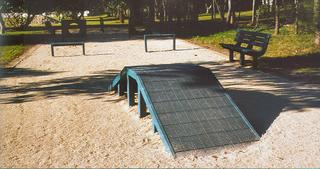

Newcastle City Council has put some agility equipment into the Tighes Hill off-leash area. It's in a nice spot - and I like the way you can sit on a bench with a beer, and send your dog up and down the line of obstacles.
It is more for adding some interest to a walk in the park, than for formal agility training, but I have been helping some of the regulars use it with their dogs and it may encourage some of them to try an agility training club. And Thommo gets to practise with distractions.
August 30, 2005
Herding

Dusty and I spent the weekend at the fifth two-day Herding Clinic at Uralla Showgrounds, under the tutelage of Robert and Jenny Cox. Pamela published my notes on the weekend on the Vicherding website.
The test/trial process is quite complicated in herding with the need to establish that the dog has 'herding instinct' before being able to compete in the trials. And it doesn't get simpler then, with various classes, and courses within classes, and different stock available. The rules will require patient study.
The Herdsman is a series of online articles covering many facets of the sport of herding from the American Kennel Club. Herding on the Web has lots of links to info.


